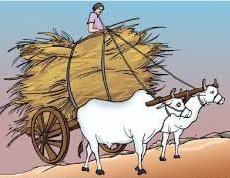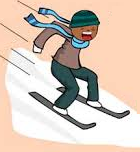Science > Physics > Force > Types of Forces
Depending upon the interaction between the bodies and level of contact forces are classified a) Contact forces b) Non-contact forces. Muscular force is a contact force. Electrostatic force is non contact force.
Contact Forces:
A force which can be applied only when it is in contact with an object is called a contact force. All mechanical forces are contact forces. The following are the examples of contact force.
Muscular Force: The force resulting due to the action of muscles is known as muscular force. Muscular force can be applied only when it is in contact with the object. For ease, a rope or handle may be used. We use muscular force to different activities using hands like lifting, throwing, catching, etc. We use the muscular force of animals to simplify our work. We use instruments with the help of muscular force. Examples of the use of muscular force are cutting of vegetables or fruits using a knife, hammering of a nail, kneading of the dough, bullocks ploughing in the field, horse pulling a cart, etc.

Friction: The force of friction always acts on all the moving objects and its direction is always opposite to the direction of motion. It always acts a point of contact between the two bodies. i.e. It arises due to contact between the two surfaces. Examples: When a vehicle is moving on a road, there is a force of friction between the surface of the road and tyres at the point of contact. Other examples are a ball rolling on ground stops after some time due to friction between the ball and the ground. If we stop pedaling a bicycle. It stops after some distance. It is due to friction between the road surface and the tyres. It is difficult to slide heavier objects on the ground. After some time the tyres of vehicle wear and tear.

Types Of Contact Forces
There are 6 kinds of forces which act on objects when they come into contact with one another. Remember, a force is either a push or a pull.
- Normal Force: A book resting on a table has the force of gravity pulling it toward the Earth. But the book is not moving or accelerating, so there must be opposing forces acting on the book. This force is caused by the table and is known as the normal force.
- Applied Force: Applied force refers to a force that is applied to an object such as when a person moves a piece of furniture across the room or pushes a button on the remote control. A force is applied.
- Frictional Force: Frictional force is the force caused by the relative motion of two surfaces that come into contact with each other.
- Tension Force: Tension force is the force applied to a cable or wire that is anchored on opposite ends to opposing walls or other objects. This causes a force that pulls equally in both directions.
- Spring Force: The spring force is the force created by a compressed or stretched spring. Depending upon how the spring is attached, it can pull or push in order to create a force.
- Resisting Forces: The air resistance is a special type of frictional force that acts upon objects as they travel through the air. The force of air resistance is often observed to oppose the motion of an object. This force will frequently be neglected due to its negligible magnitude (and due to the fact that it is mathematically difficult to predict its value). It is most noticeable for objects that travel at high speeds (e.g., a skydiver or a downhill skier) or for objects with large surface areas.
Non-Contact Forces:
A force which can be applied without any contact with two bodies is called a non-contact force. The following are examples of non-contact force.
- Magnetic Force: The force exerted by a magnet is called a magnetic force e.g. Like poles of a magnet repel each other, while unlike poles attract each other. These forces exist without contact between the two magnets. e.g. i) Magnet attracts Cobalt, Nickel, Iron and steel towards itself. ii) When two magnets are brought near then South-South, North – North poles repel each other. While North and South pole attracts each other.
- Electrostatic force: The force exerted by a charged body is called an electrostatic force e.g. Like charges repel each other, while unlike charges attract each other. These forces exist without contact between the two bodies. e.g. i) When a comb is run through dry hair, then the comb can attract small pieces of paper. ii) If we bring a charged comb near our hair, they rise towards the comb. iii) A charge is developed on synthetic fibre due to rubbing. iv) We can hear the cracking sound of sparks when taking off or putting on woolen or synthetic clothes.
- Gravitational force: The force exerted by the earth on a body is called gravitational force. Actually this force exists between any two bodies in the universe. This force is always of attraction. e.g. When a body is dropped from a height it moves in a downward direction towards the Earth with increasing speed (with constant acceleration). This constant acceleration by which all bodies fall down is called acceleration due to gravity. Its value is 9.8 m/s² (approx 10 m/s² )on the surface of the earth. e.g. i) A fruit from tree falls down; ii) Water falls down on the ground from a tap. iii) We feel the weight of a bucket full of water holding in our hand.
Force field:
Region or space in which non-contact force such as magnetic force, gravitational force, electrostatic force acts is called force field. The region surrounding a magnet, where magnetic substance experiences force is called the magnetic field. The region surrounding an electric charge, where electric charge experiences force is called the electric field. Thus a field is a sphere of influence of non-contact force.
Previous Topic: The Concept of Force
Next Topic: Concept of Balanced and Unbalanced Forces
8 replies on “Types of Forces”
I want physics
Click on the fact factor logo at the top, you will be directed to the home page and then select physics from the list.
He gave physics only
We are publishing notes for Physics, Chemistry, Biology, Mathematics and also for LLB and Management. Just use serach option to find your topic. Thanks for your comment
This is very good
This was so helpful in making a study guide for science.
Yes
I understand this